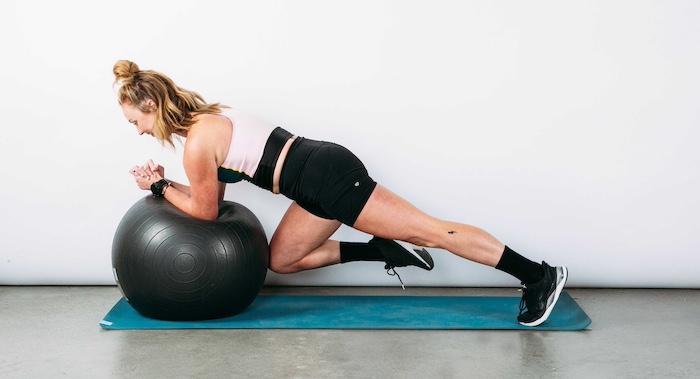
The numerous applications of the exercise ball follow a range of difficulty levels, and the benefits for back pain patients can be felt at each level. From merely sitting on the exercise ball to doing structured aerobic exercise routines, the basic support needed by the back and stomach muscles is the same.
For low back pain, the exercise ball can be used for a variety of purposes, including:
- Find a neutral spine position
- Learn proper posture
- Increase lumbar (low back) mobility
- Increase abdominal and back muscle strength
- Increase balance and stability
- Develop overall control and strength of the core body muscles
- Learn to lift properly
Introduction To Using An Exercise Ball
As an introduction to exercising on the ball, it is often recommended that one simply sit on one for 30 minutes a day and bounce lightly, continually finding and maintaining balance on the ball.
Another recommended first step on the exercise ball is to find a neutral (lordotic) lumbar spine position.
- Slouch slightly on the exercise ball, rounding the lower and upper back
- Begin bouncing lightly on the exercise ball
- Allow the body to automatically find the straightened posture, which promotes staying balanced while continuing to bounce on the exercise ball
This balanced position on the exercise ball is also referred to as the center of gravity, where the upper body is balanced on a stable pelvic base. Even a slight change in this neutral posture position will change the center of gravity and require a correction to stay on the exercise ball. The stomach muscles are needed to work the entire time to keep this balanced, neutral posture.
Everyday Uses For The Exercise Ball
Lifting objects is a frequent cause of low back injury and muscle strain, and certain exercises with the Swiss exercise ball can be useful in teaching the proper body mechanics and posture while lifting.
Ergonomic Lifting
- Place the exercise ball against a wall at the small of the back, spreading the feet shoulder-width apart and 1 to 2 feet in front of the hips.
- With hands on hips and knees bent slightly; squat down halfway without leaning back into the exercise ball, but letting the ball guide the position of the back. Knees should not extend over toes.
- Return to standing. Repeat 5 times.
- Increase difficulty by holding a squat for 10 seconds.
This exercise is a good movement to practice with a spine specialist (such as a physical therapist or occupational therapist) who can guide you in identifying the proper position to use for lifting.
Sitting on an Exercise Ball
The exercise ball can also be used as a replacement for a chair at work or home. The movement of the exercise ball requires a muscular response to keep one's center of gravity and maintain balance on the ball. This stimulates the deeper trunk muscles (multifidus and transverse abdominus) that are important in supporting the spine and reduces static loading on any one structure in the spine.
Exercise Ball for Support During Pregnancy
For pregnant women, exercise balls can be an aid in exercising while supporting the extra weight and change of center of gravity caused by pregnancy. During labor, the exercise ball can also be used to provide support for certain positions, rhythmic movement gentle bouncing, and more.
Precision Pain Care and Rehabilitation has two convenient locations in Richmond Hill – Queens, and New Hyde Park – Long Island. Call the Queens office at (718) 215-1888 or (516) 419-4480 for the Long Island office to arrange an appointment with our Interventional Pain Management Specialist, Dr. Jeffrey Chacko.













